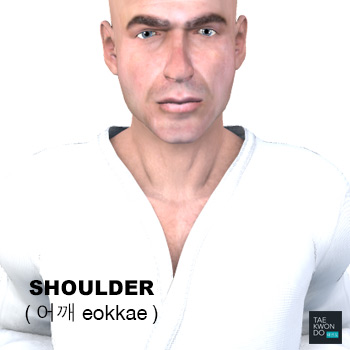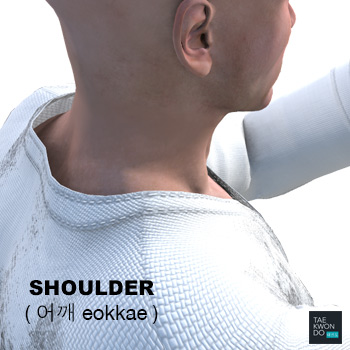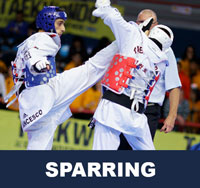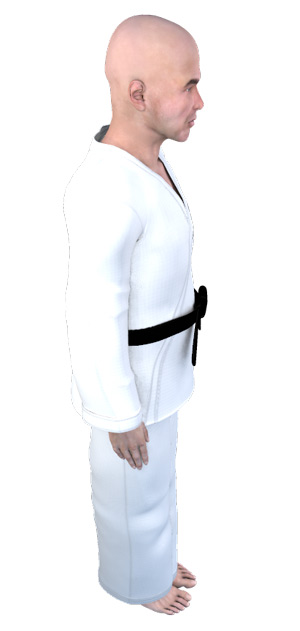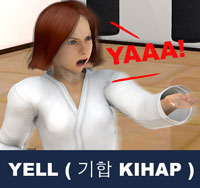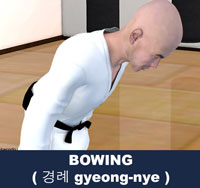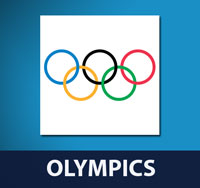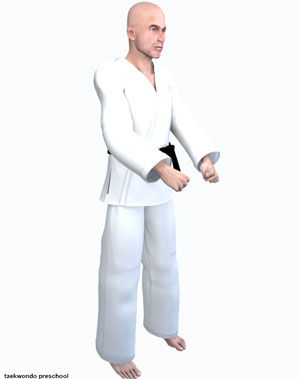Taekwondo 태권도Taekwondo Preschool
Promotion from one geup to the next can proceed rapidly in some schools, since schools often allow geup promotions every two, three, or four months. Students of geup rank learn the most basic techniques first, and then move on to more advanced techniques as they approach first dan. Many of the older and more traditional schools often take longer to allow students to test for higher ranks than newer, more contemporary schools, as they may not have the required testing intervals. View Taekwondo belt levels »
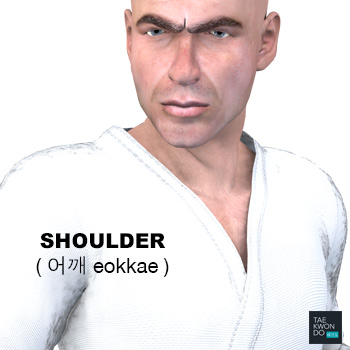
Shoulder
( 어깨 eokkae )
Difficulty Level: Beginner Surface: Defensive
The human shoulder is made up of three bones: the clavicle (collarbone), the scapula (shoulder blade), and the humerus (upper arm bone) as well as associated muscles, ligaments and tendons. The articulations between the bones of the shoulder make up the shoulder joints. The shoulder joint, also known as the glenohumeral joint, is the major joint of the shoulder, but can more broadly include the acromioclavicular joint. In human anatomy, the shoulder joint comprises the part of the body where the humerus attaches to the scapula, and the head sits in the glenoid cavity. The shoulder is the group of structures in the region of the joint.
The shoulder joint is the main joint of the shoulder. It is a ball and socket joint that allows the arm to rotate in a circular fashion or to hinge out and up away from the body. The joint capsule is a soft tissue envelope that encircles the glenohumeral joint and attaches to the scapula, humerus, and head of the biceps. It is lined by a thin, smooth synovial membrane. The rotator cuff is a group of four muscles that surround the shoulder joint and contribute to the shoulder's stability. The muscles of the rotator cuff are supraspinatus, subscapularis, infraspinatus, and teres minor. The cuff adheres to the glenohumeral capsule and attaches to the humeral head.
The shoulder must be mobile enough for the wide range actions of the arms and hands, but stable enough to allow for actions such as lifting, pushing, and pulling.
* Please see a certified Master Instructor ( 사범님 sabeomnim ) for training. Proper guidance and instructions are needed to ensure safe training.

Impact Surface Area
Various surfaces of the hand and feet may be engaged as the striking or blocking surface depending on which area of the opponents body is being targeted. This leads to a large array of hand and feet positions. The human body's shape is determined by a strong skeleton made of bone and cartilage, surrounded by fat, muscle, connective tissue, organs, and other structures. For more information View Impact Surface Area »
- Fist ( 주먹 jumeok )
- Hammer Fist ( 메주먹 mejumeok )
- Hand Blade ( 손날 sonnal )
- Ridgehand ( 손날등 sonnal-deung )
- Forearm ( 앞팔 ap-pal )
- Inner Wrist ( 안팔목 anpalmok )
- Outside Wrist ( 바깥팔목 bakkatpalmok )
- Elbow ( 팔굽 palgup )
- Back Knuckle ( 등주먹 deung-jumeok )
- Arm ( 팔 pal )
- Hand ( 손 son )
- Finger ( 손가락 songalag )
- Palm ( 손바닥 sonbadak )
- Palm Heel ( 바탕손 batangson )
- Fingertips ( 손끝 sonkkeut )
- Scissors Fingertips ( 가위손끝 kawisonkkeut )
- Combined Two Fingertips ( 모은두손끝 moeundusonkkeut )
- Single Fingertip ( 한손끝 hansonkkeut )
- Combined Three Fingertips ( 모은세손끝 moeunsesonkkeut )
- Flat Fingertips ( 편손끝 pyeonsonkkeut )
- Back Hand ( 손등 sondeung )
- Wrist Area ( 팔목 palmok )
- Back of the Wrist ( 등팔목 deung-palmok )
- Base of the Wrist or Inner Wrist ( 밑팔목 mitpalmok )
- Arc Hand ( 아금손 ageumson )
- Pincers Finger ( 집게주먹 jipgejumeok )
- Bent Wrist ( 굽힌손목 gupinsonmok )
- Curled Fingertips ( 모둠손끝 modumsonkkeut )
- Extended Knuckle Fist ( 밤주먹 bamjumeok )
- Half-clenched Fist ( 편주먹 pyeonjumeok )
- Trigger Finger Fist ( 집게밤주먹 jipgebamjumeok )
- Curled Hand ( 곰손 gomson )
- Foot ( 발 bal )
- Ball of the Foot ( 앞축 apchuk )
- Instep of the Foot ( 발등 baldeung )
- Bottom of the Heel ( 뒤축 dwichuk )
- Sole of the Foot ( 발바닥 balbadak )
- Foot Blade ( 발날 balnal )
- Shin ( 정강이 jeonggangi )
- Ankle ( 발목 balmog )
- Reverse Foot Blade ( 발날등 balnaldeung )
- Tips of the Toes ( 발끝 balkkeut )
- Knee ( 무릎 mureup )
- Back of the Heel ( 뒤꿈치 dwikkumchi )
- Back of the Knee ( 오금 ogum )
- Thigh ( 허벅지 heobeokji )
- Head ( 머리 meoli )
- Face ( 얼굴 eolgul )
- Human Eye ( 눈 nun )
- Ear ( 귀 gwi )
- Temple ( 관자놀이 gwanjanoli )
- Nose ( 코 ko )
- Teeth ( 이 i )
- Chin ( 턱 teog )
- Jaw ( 턱 teog )
- Throat ( 목구멍 mokgumeong )
- Neck ( 목 mok )
- Cervical Vertebrae ( 경추 gyeongchu )
- Shoulder ( 어깨 eokkae )
- Collarbone ( 쇄골 swaegol )
- Chest ( 가슴 gaseum )
- Ribs ( 늑골 neuggol )
- Sternum ( 흉골 hyung-gol )
- Abdomen ( 복부 bogbu )
- Groin ( 샅 sat )
- Hamstring ( 햄스트링 haemseuteuling )
There are five tenets defined in the International Taekwondo Federation (ITF) and several more in World Taekwondo (WT).
Self-control ( 극기 geuk-gi ): "This means to not only have control over one's physical acts, but also their mental thoughts and actions" View Taekwondo Tenets »
RESOURCES
This article uses material from the Wikipedia articles "Shoulder" and "List of Taekwondo techniques", which is released under the Creative Commons Attribution-Share-Alike License 3.0.


